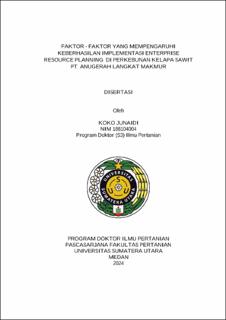Faktor Faktor yang Mempengaruhi Keberhasilan Implementasi Enterprise Resource Planning di Perkebunan Kelapa Sawit PT. Anugerah Langkat Makmur
Factors Influencing the Success of Enterprise Resource Planning Implementation in Palm Oil Plantations PT. Anugerah Langkat Makmur

Date
2024Author
Junaidi, Koko
Advisor(s)
Rahmanta
Chalil, Diana
Wibowo, Rulianda Purnomo
Metadata
Show full item recordAbstract
Palm oil plantation are the sector agriculture control long-range system. This leads to the inspections of plantation work processes, as well as performance assessments, being conducted through visits to plantation/factory locations in the regencies, known as work visits. Digital facility that keep on developing by The Government of Republic Indonesia as a possibilty for Palm Oil Plantation to develop intergrated web-based business management by leveraging digitization. Oil Palm Company builds network infrastructure connected to internet facility and proceed to builds Oil Palm Plantation management through intergrated system between departments and/or between departments and business units, reffered to as Enterprise Resource Planing (ERP). PT. Anugerah Langkat Makmur (PT. ALAM) requires a very long time for implementation and requires substansial funding for its implementetion
Company performance improvement through production target achievement has been achieved over the past 5 years. Similarly efforts to achieve the target direct cost of palm oil mills per kg of CPO for 5 (five) years by PT. ALAM have not been achieved. This contradicts the success of ERP implementation which is supposed to increase efficiency and production and productivity. This urge the author to conduct a Pre-survey at PT. ALAM aimed at identifying the most selected factors by PT. ALAM employees, ERP users, in influencing the success of ERP implementation. The top 10 factors obtained from the Pre-survey at PT. ALAM that designed to : adoption intention response, perceived usefulness, integration, top management commitment, employee training, organizational fit with ERP, organizational factors, user satisfaction, perceived user ease, and business process improvement.
Assosiative research in this study analyze interactive relationship of user perceive ease, user satisfaction, usefulness perceive, intention to use ERP, intention to use ERP, workforce diversity, top management commitment, ERP training, business process improvement, organizational fit, and ERP implementation success in oil palm plantations PT. Anugerah Langkat Makmur with five business units namely: 1. Sei Lepan Plantation, 2. PKS Bukit Mas, 3. Sei Litur Plantation, 4. Tiga Juhar Plantation, and 5. Madina Plantation. These five business units are managed by one Board of Directors Office (Head Office). The sampling technique used non-probability sampling with Judgement sampling type purposive sampling method. Data collected in this study include: 1. Primary data obtained from interviews & documentation, 2. Secondary data obtained from company issued reports. The data analysis technique used is Component-based Structural Equation Modeling (Varian Based SEM) through Partial Least Square (PLS) using Smart PLS 3.0 software.
From the research results, it is obtained that the number of respondents research objects is 116 people and questioner collected is 94 people. Composite reliability value of each construct is bigger 0.70 and average variance extracted of each construct is bigger 0.5. This is show that every construct qualifies validity requirements. Reliability test obtained all Cronbach’s alpha value stated that each construct meets the requirements. The R-Square known as a value of ERP Implementation Success in Research Model I based on individual related is 0.524, which means that ERP Implementation Success of 52.4% can be explained by User Satisfaction, Perceived Usefulness, and Intention to use ERP. R- Square value from ERP Implementation Success of research model II based on critical success factors identified is 0.627, which means The ERP Implementation Success of 62.7% can be explained by Top Management Commitment, Training, all direct relationships between variables both Research Model I based on individual related and Research Model II based on critical success factors identified are positive and significant. Indirect relationships through significant intervening variables in Research Model I consist of two indirect relationships out of six indirect relationships namely: 1. Perceived ease of use -> Perceived usefulness -> ERP implementation success and 2. Perceived usefulness -> Intention to use ERP -> ERP implementation success. Similarly, indirect relationships through significant intervening variables in Research Model II consist of one indirect relationship out of six indirect relationships namely: Top management commitment -> Training -> ERP implementation success.
